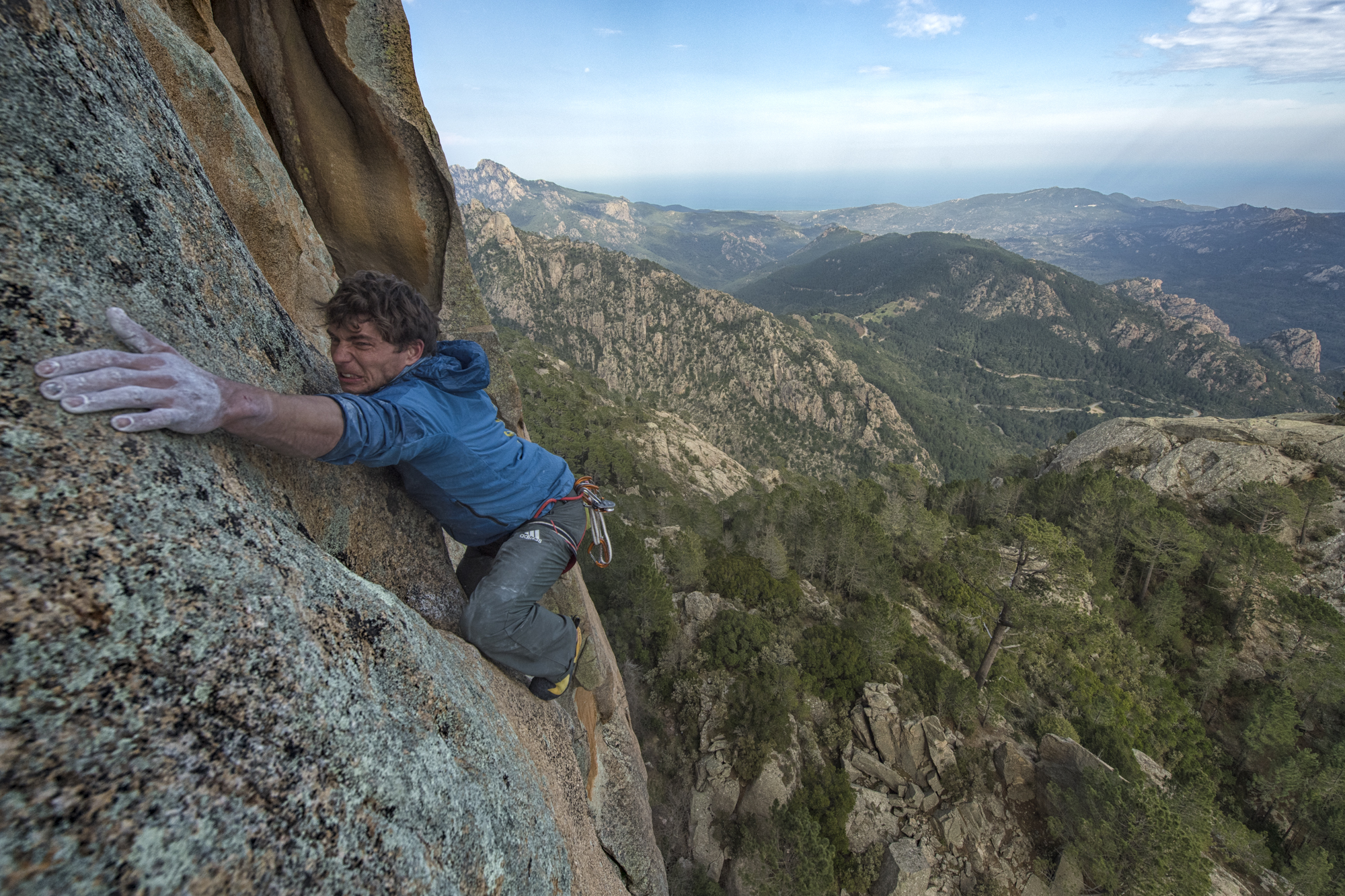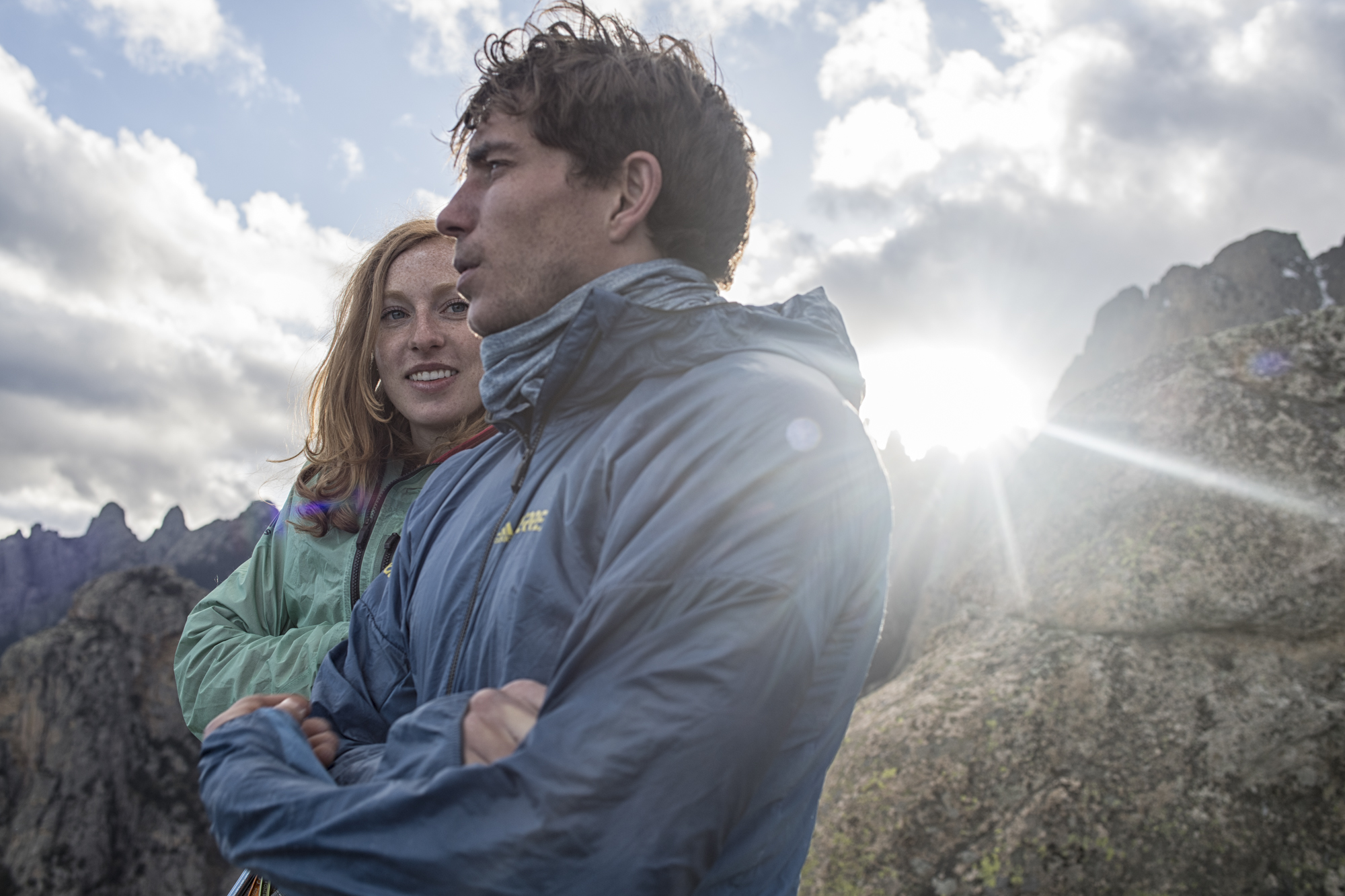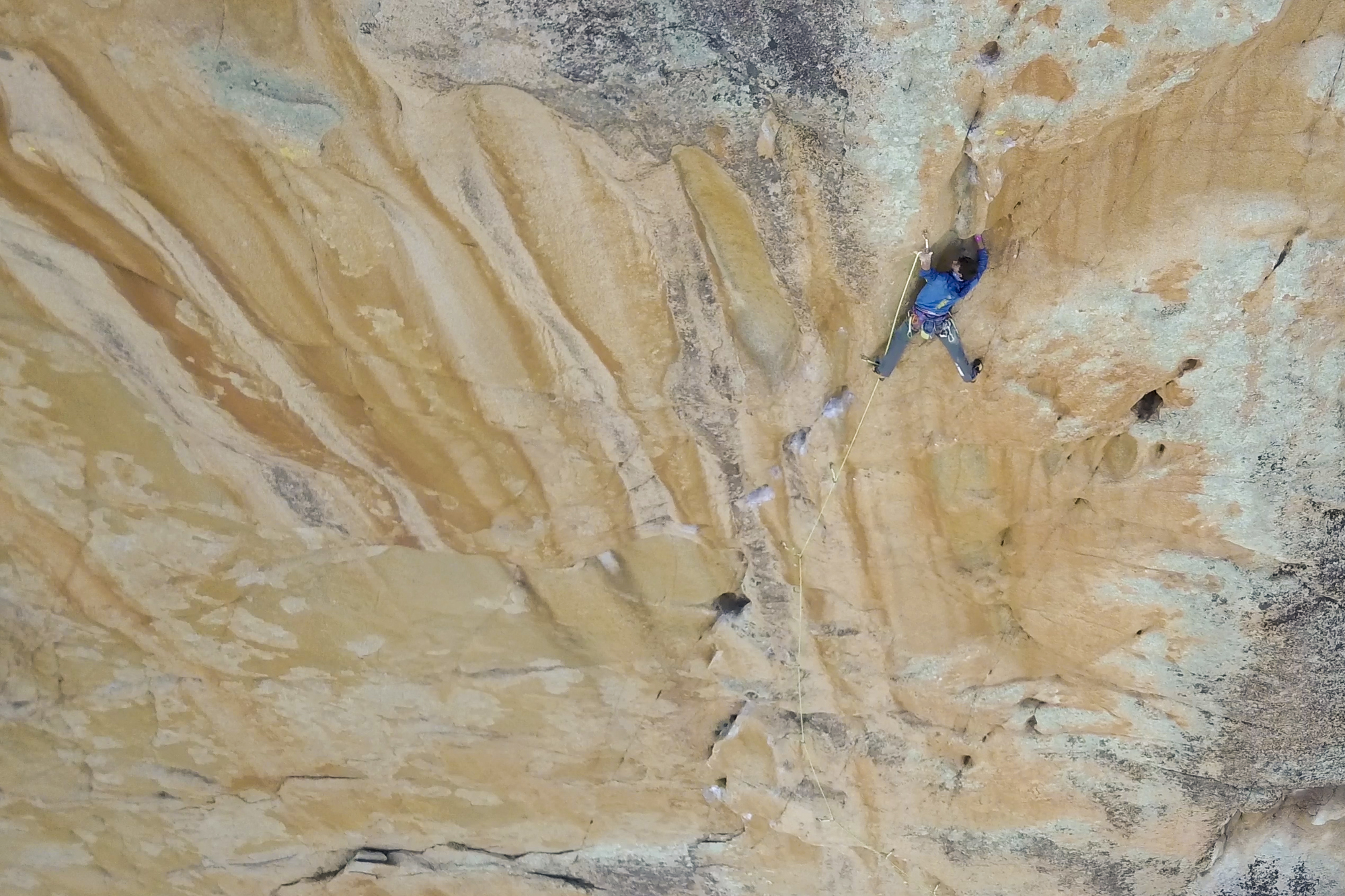Whitecaps flashed against a sandy shoreline. From my lofty belay 10 miles east, I braced against a frigid breeze off the snow-clad Alta Roca mountains. The cold of the Mediterranean island of Corsica had been the first surprise. The difficulty of the route Delaney and I had been trying was the other.
For much of March and April we’d battled Delicatessen. Its paper-thin crimps and razor crystals, and its 2,000-foot Stair-Master approach up manzanita and through sharp vegetation had nearly crushed us. I was, it seemed, held together with duct tape, and more likely to swim back to my Mom’s lavender farm in Colorado than to climb the six-pitch route done over a quarter century ago.
I tied off to the belay at the end of the first pitch. Did I dare look up at the remaining 400 feet of golden stone? My eyes dropped to the sheet of stone beneath my rockshoes. Specks of blood glistened in the creases of my palms and fingers, mementos from the crimps on the opening 5.14 pitch.
The mechanical clack of a camera shutter snapped me to attention. Jeff Rueppel, one of my closest friends, and who was along to document the spectacular route, hung from a green 9 mil tied to the wall.
Jeff is a “Technology Evangelist” for Adobe, a fancy way of saying that he promotes and demonstrates the company’s products. For the past three years Adobe has had him “on the beach,” a tech-industry term for employees who don’t have to regularly report to an office, and have abundant free time. When he isn’t pontificating about Lightroom or Photoshop, Jeff travels the world shooting climbing.
“What are you going to do?” Jeff asked.
“We’re losing light!” yelled Delaney Miller, hovering down on the ground, trying to stay warm. Delaney, a 22-year-old rock prodigy with hair as red as a Texan sunset and eyes as blue as
a calm mountain lake, is a world-cup competitor unused to defeat. Over the past month we’d swapped belays working out Delicatessen’s moves.
Standing five-foot-eight and long-limbed, I’d been able to make all of Delicatessen’s cruxy spans, but several reaches had just been too much for Delaney’s five-foot-four stature. Finding no in-between holds for workarounds, and with just a few days left on our trip, she had swallowed hard and shelved her climb to help me.
Above us lay a formidable stretch of old-school face climbing up to 5.13, the sort of stuff that requires the touch of a corneal surgeon. In the wrong light the rock can seem impossibly blank. Even when you can see holds, the just-off-vert granite delivers the sort of movement that fell from favor decades ago. The style—frustrating to hateful—explains why on Corsica, a rock fortress strewn with boulders, ripped with precipitous gorges and bursting with spires, we could count all the climbers we’d seen in a month on one hand. According to Jean Louis Fenouil, author of the guidebook to Corsica, the island is largely undeveloped, with just 400 routes and perhaps 200 climbers.
Making the right decision hung heavy. It wasn’t just the climbing, but the responsibilities of the trip sat on me like a 200-pound gorilla. Although I’d been on trips all over the world, I had never been the leader. I’d just tagged along. Now, in Corsica, the success or failure of the trip rested with me.
Jeff had worked his tail off humping and fixing ropes, and had hung patiently, chafing in his harness to get the shots. Every day he had hiked out, his pack tottering with the Goggle camera, a bug-eyed contraption of 16 cameras bolted together. Would anyone want photos and video if we didn’t succeed?
Delaney, like Jeff, had also endured. Hailing from balmy Dallas and with maybe one percent body fat, she had practically turned translucent from the cold. She had also dealt with a pack that weighed nearly as much as she does, and one day faced a runout that most climbers would later relate to their grandchildren. Now she was selflessly helping me. Would that also be for nothing?
Corsica, the “Isle of Beauty,” is popular among European hoi polloi, but overlooked by Med-bound Americans who know only of the limestone of Kalymnos or Sardinia. Corsica, a collective territory of France, and birthplace of Napoleon, is but a seven-mile swim from Sardinia and 50 miles from the vineyards of Tuscany. Roughly the size of New Hampshire, the island is about half national parkland and its entire population is less than that of Honolulu. Though they are citizens of France, Corsicans are fiercely independent, with their own language, cuisine and culture. Most road signs are in Corsican and French, with the French part X-ed out with spray paint.
The beach perimeter of Corsica is dotted with resorts, but two-thirds of the island are mountains. Roughly 120 peaks rise from sea level to over 6,000 feet. The vertiginous terrain is rugged to impassable, and across it wends Europe’s most difficult trail, the GR-20, a 108-mile trek that traverses the island north to south and takes most hikers two weeks to complete.
Stage 14 of the GR-20 draws near the Aiguilles de Bavella. These seven needles stab skyward and could be stand-ins for the Alps. Even in spring they stand against a backdrop of snow, another surprise for a first-time visitor to the Mediterranean island.
Near the needles is the Col de Bavella. Accessed by highway D268, one of the few real roads that cleaves the island longitudinally, this pine-wooded saddle has iconic views and an icon itself, the marble shrine of Notre Dame des Neiges, or Our Lady of the Snow. On the eastern side of the col, about 15 minutes downhill by car to the trailhead, lies Punta di U Corbu, a 500-foot granite monolith and the home of Delicatessen.
Three years ago I’d studied a 1992 photo of legendary route developers Arnaud Petit and Stéphane Husson on Delicatessen. I was instantly hooked. Petit, rocking a mullet and cutoff jeans, was bolting, on lead amazingly, hanging on with one hand and drilling with the other, the center line of Punta di U Corbu. Onsighting and drilling where they could, Petit and Husson forged their line, but pulled bolt to bolt through the cruxes, finding the climbing too stout for them at the time.
An older and stronger Petit returned in 2001 to free the route. The second ascent, by Cedric Lacat and Nina Caprez, waited a full decade later. By 2017 Delicatessen had seen just seven ascents.
Last spring an opportunity dropped in my lap. Google asked Jeff to shoot something spectacular to show off its new Virtual Reality camera system. Sporting huecos the size of homes and with sculpted stone waves that would give Katsushika Hokusai pause, Delicatessenis a natural wonder—the perfect set for the Google project.
Imperfectly, I had no one to climb with.
Then I chanced upon Delaney Miller who said she needed a break from competitions. I framed an ascent of Delicatessen as a romp on a Mediterranean island, with beaches and sun. I didn’t mention that, locked among snow-clad mountains, we would see little of that.
Two weeks before we were to leave, we reviewed the logistics of gear, travel and multi- pitching.
“Have you ever done a multi-pitch?” I asked.
“Not really. In fact, I can probably count the number of times I’ve climbed outside, but that’s fine, it’s just a 5.14a,” she said.
“Have you rappelled?”
“No.”
I’d only known Delaney by reputation as a tough and successful competition climber, but I
was also aware of her quick send of Chris Sharma’s testpiece Zulu (5.14a) at Rifle.
Our first week on Corsica was rude. Thick clouds at the Col de Bavella butted against massive walls. We strained for a view. When we finally could see, the formation of Punta di U Corbu was unrecognizable in the vast landscape of innumerable walls, and we drove back and forth seeking it, battling carsickness on a snake of asphalt that rarely let Jeff upshift from
second gear.
“It’s like looking for a needle in a stack of needles,” Delaney said, craning her head at the walls. “Why would you make a road like this?” I moaned.
A tavern owner later informed us that being able to access Corsica’s interior by vehicle is
a modern luxury. And the few roads that do traverse the mountains can be little better than widened animal tracks. Indeed, you can drive for hours and dodge more sheep than cars.
“Maybe we should have looked up the location of the crag,” I said as Jeff, at the helm of the rental car, whipped the wheel hard to the left, then hard to the right, then back.
“Ya think?” Delaney said, stroking a finger through the air as if she was marking a point on an invisible scoreboard.
Spotting two women hauling climbing gear from their car trunk, Jeff stopped, leapt out and fired off questions in the perfect French he had learned from Bleausards while living in Paris, where he taught school for two years.
Fingers pointed in the direction of the mountains behind us, the women indicating that our wall was behind a massive feature we’d already agreed was “not it.”
Twenty minutes down the trail, we were lost. Faint paths braided through dense vegetation and an hour-and-a-half approach turned into five hours of prickly bushes, vines and third-class scrambling. As I tumbled down an embankment, I questioned whether humans had ever passed this way. An hour later the bolts of Delicatessen affirmed that they had.
“You look awful,” Delaney said cheerily
picking a leaf from my hair.
“You do look awful,” Jeff chimed in.
Delaney hummed thug-life music she’d blasted in the car. We dumped our gear, fixed the first pitch, pulling through on bolts, and hoofed it out of there, hoping to pick up the real trail on the way out only to realize that we were on it.
We stayed in Quenza, 45 minutes away by car. A relic of a village, Quenza was nearly devoid of human life. Cattle, wild sheep and feral pigs roamed the streets uninhibited. Overlooking the medieval town was a castle that could have been built by Bram Stoker himself.
“Now I know where all the people have gone,” I said when I saw the castle.
Our job on our first real outing to Delicatessen was to fix a static line to the summit of the monolith by any means possible. With one rope fixed, I observed as Delaney struggled to jug up it.
“Do you want help?” I asked.
“No, I got it,” she said defiantly, not understanding why the rope wouldn’t slide through her rig.
“The rope goes on the inside of the biner,” I said, after a few minutes.
After making sure she was safe, I jugged to the first anchor. Forty minutes and a nap later, I heard Delaney approaching the anchor.
“Jugging sucks!” she moaned, her left arm smoked from basically doing one arms the full length of the pitch.
The sun disappeared behind the east-facing wall, and almost immediately it felt as if someone had left the freezer door open. We pulled our thin jackets tight. Racked and ready, I adventured through pitch two and sat for an hour at a wind-battered hanging belay as Delaney climbed to meet me.
“Pitch three is yours,” I said.
“Th-Tha-Thanks,” she stuttered through clenched teeth.
For two hours neither of us had much luck. Delaney fought up
technical crimps and finicky foot smears. I tried to weave the rope into a blanket. The chalkless holds were elusive. Until this point, the bolts had been close enough to pull through on at tough sections. But here, Petit must have just gone for it and run it out.
Unable to do the moves to the next bolt, we abandoned the goal for that day and hiked down, our heads hanging.
That night I sat brooding in the kitchen of our BNB in Zonza. We feasted on a budget dish of pasta and tomato sauce, saving our precious funds for special occasions to sample Corsican fare, often wild boar in a hearty stew or with fresh-cut linguini. While delicious, wild boars are a nuisance on the island, and have been so since the time of Charlemagne, who created the lieutenants de louveterie, a force of hunters paid to keep the beasts thinned to a tolerable level. Twelve-hundred years later, they are still working.
On our next outing we did make it bolt to bolt, fixed to the summit and began the arduous process of learning the moves. Two weeks later I had redpointed each pitch, although not in a row on the same day. Until that was done, I couldn’t claim an ascent.
Delaney, meanwhile, was stymied by the first 5.14, pitch one.
“I don’t think I am going to be able to do this,” she said after three weeks’ effort. She sat in the dirt staring at the wall, her words catching in her throat. “I can’t put it together in the time we have left. I’ve failed,” she said.
I chuckled and twisted a stick into the dirt.
“Why are you laughing?” she asked, lightning flashing in her eyes. “Déjà vu,” I said. “Been there. We just need to shift gears and still
come out of this with a win.”
“How?” she asked.
“You should focus on pitch one as your objective. I’ll keep trying
to link the pitches.”
And that we did. My first two attempts to climb ground to top
ended miserably. My mood soured as each sharp crystal dug into my raw tips. My motivation dimmed, then died. With our trip nearing its end, it didn’t look like we were going to do the climb.
“What do you want to do?” Delaney asked one day as we dropped back to the car.
I stopped on the trail.
Twilight dappled the valley, painting the walls purple, red, orange and blue. We sat watching
the light fade. Then I remembered why we were here. We weren’t here for the sponsors or to make a video or get pictures. We were here for moments just like this.
“We have to keep trying,” I said.
Days away from the wall were infrequent and we maximized them by cramming into the car and exploring other climbing possibilities. Our biggest outing was to Calanques de Piana, a six-hour drive northwest, where the red-granite formations are so spectacular they are a UNESCO World Heritage Site. Here, at a high col near the sea and roadside sits a stash of fine blocks including the Tete de Chien, a house-sized boulder with huecos and waves that begged for climbing. We didn’t have pads and the landing was a back breaker, but curiosity overrode caution, and Delaney and I pawed around the highballs while Jeff clicked away with his camera.
Besides being an outstanding photographer, videographer, teacher and spokesperson for Adobe, besides speaking fluent French and always being in an up mood, Jeff is also
practically a sommelier. Since you can’t drive 30 minutes along Corsica’s coast without passing a vineyard, Jeff constantly wore a smile. Corsicans have been vintners since 570 B.C., and when Corsica was ruled by Italy, the Italians so prized the wine and its secrets that they banned its export for 500 years.
After a day’s rest, and loaded up on food, we returned to Delicatessen where I surprised myself by dispatching pitch one. Incredibly, Delaney followed, also climbing no falls, flowing over moves that had been impossible for her.
I was stunned.
“What was that?” I asked.
“That was me finally climbing,” she said,
breaking into a grin. “You got this,” said Delaney, clipping the draws that she’d collected to my harness.
For three hours we pushed up the wall, Jeff shooting alongside us with his weird crazy camera, Delaney climbing. Since she’d spent most of her time low on the wall, the upper section was practically new to her. In the name of expediency, she pulled through on draws when she had to.
Pitch four, the sharpest and most technical of the six, doesn’t carry the hardest grade, but it was the crux for me. This monster crawls from a sculpted cave to a spooky stance on a three- inch spike of stone that juts out like a unicorn horn. After that, the wall bulges to overhanging, and your battered tips get to taste a final ladder of micro-crimps. Manage that, and a modest bit of 5.11 gains the summit.
When Delaney had had her struggles on pitch one, I had told her to narrow her goal to just one pitch. It had sounded like Yoda bullshit then, but it had worked.
“One pitch at a time,” I told myself, thinking my B.S. might also work for me.
I pulled onto the rock.
“This is a moment, be present,” Delaney said, channeling a bit of Yoda herself.
Surprised by having climbed to here without falling, I was surprised again to discover
that rain had washed off my tick marks and chalk on this cruxy section. In my tired state I couldn’t remember the moves and began bungling them. I felt the bite of the rock, the pressure of the rubber on my shoes, and improvised a new sequence doing sideways mantels off credit-card crimps. Drops of sweat and blood patterned the holds, but I fought to the chains and after 30 minutes of anxiety punched the still air with a single word.
“Off!”






